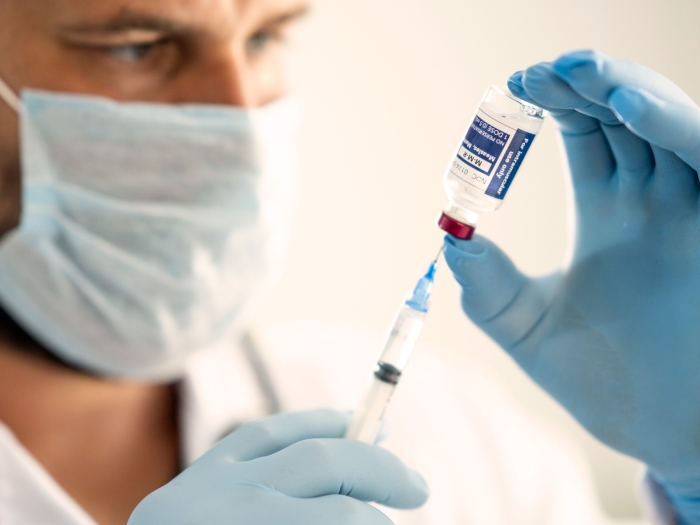The blood-analysis tool, which requires just a microliter of blood, could one day help treat pediatric intensive care patients nationwide.
8:00 AM
Author |

A multidisciplinary University of Michigan team has developed a device to quickly assess the immune response in pediatric intensive care patients.
The device eventually could be used in ICUs nationwide to help treat children who have developed overwhelming sepsis, for example.
In these cases, the body initiates an inflammatory immune response, which is a normal, natural thing. This allows the immune system to fight bacteria that may have entered the body, and powers the body to start repairing damaged tissues.
All too often, though — in up to 80 percent of patients admitted to a pediatric intensive care unit — that normal inflammatory response becomes dysregulated, the effects of which can be quick and dangerous. Sepsis, for example, can lead to tissue damage, organ failure and death.
"It's important for us to know how a child's immune system is behaving in a situation like this," says Timothy Cornell, M.D. Cornell is a pediatric critical care intensivist at the University of Michigan's C.S. Mott Children's Hospital and a member of the team of clinicians and engineers that developed the device.
"The standard of care right now to see what's going on with a patient's immune response is a test that measures the cytokines — inflammatory proteins — in the blood. But it can take hours at a hospital like ours with access to our own lab, and even days at a hospital that has to send the tests out, which is not uncommon," Cornell explains.
For critically ill children, doctors don't have that kind of time.
Further, the tests require 50 to 100 microliters of blood. Although that doesn't sound like a lot, drawing that amount routinely from a sick child can be a challenge.
This motived Cornell and a U-M team, which also includes U-M engineers Jianping Fu, Ph.D., and Katsuo Kurabayashi, Ph.D., to find a better solution. The group's microfluidic device uses a miniscule amount of blood — a microliter — to provide test results in 20 minutes.
"Today, making decisions about a child's care relative to the immune response underway in his body is like standing in the middle of a teeter-totter, trying to keep it balanced while blindfolded. You have to guess whether you should move a little to the left or the right. With this new test, it's like you finally aren't wearing a blindfold," says Cornell.
The benefits of taking off the blindfold could be game changing.
This test will help us see who's at higher risk for sepsis and which patients may need more aggressive inflammatory modulating therapies.Timothy Cornell, M.D.
From research to clinical application
Traditionally, patients with sepsis are treated for the most part the same.
"Whether you're 60 years old, 6 years old or 6 months old, we're basically using the same one-size-fits-all treatment protocol. It's basically supportive therapy to assist your body while it hopefully comes around. We've been doing it that way for more than 30 years," says Cornell.
This approach — a combination of fluids, blood pressure medicine and antibiotics — has significantly decreased mortality among this patient population. But it doesn't work for about a third of the patients.
"Thirty percent of patients going into organ failure from sepsis is just too high in our opinion. We have to do better," says Cornell.
The device has already played an important role in the care of a pediatric cancer patient who was experiencing a catastrophic immune system reaction. She had been receiving experimental cancer treatment and was starting to show signs of organ failure.
Although the device is in the research phase, the Food and Drug Administration's Expanded Access program allowed its use in this case. The girl's oncologist used information provided by the test to support adjustments to her course of treatment and immune therapy. Her condition rapidly improved because of the therapy, and she was eventually discharged home.
The technology brings immune response management into a new era of precision medicine, allowing doctors to treat a patient based on the individual situation versus applying a standard protocol universally.
"It's not so much a diagnostic tool so much as a prognostic tool to identify which patients are at the highest risk of going into immune dysregulation," Cornell says. "From there it also serves as a predictive tool to help doctors predict which treatment course would be most effective to bring things back into balance.
"This test will help us see who's at higher risk for sepsis, and which patients may need more aggressive inflammatory modulating therapies. And because this tool is faster and requires significantly less blood, we can repeat it to keep a close eye on things — [and] watch to see if we've had the desired results."
Cornell and his colleagues have formed a company around the new device, PreDxion. They've received funding from the Coulter Foundation and additional funding from the U-M Michigan Translational Research and Commercialization for Life Sciences Program.
Currently, their business focus is on creating relationships with manufacturers that can help them scale production up from four to 400 devices a day.
The PreDxion team expects to have a clinical trial operating at a handful of centers in 2017 with an eye on expanding to a large clinical trial within the next few years to identify whether the device supports improved outcomes across various institutions.
"Five years from now, the PreDxion test could be every bit as much a standard part of an ICU doctor's arsenal," Cornell says.

Explore a variety of healthcare news & stories by visiting the Health Lab home page for more articles.

Department of Communication at Michigan Medicine
Want top health & research news weekly? Sign up for Health Lab’s newsletters today!





